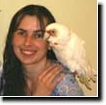

I own a vulture!
Perhaps one of the most disturbing aspects of owning Lady Gouldian Finches is when they begin to lose their head feathers and take on a rather vulture looking appearance. For many years we have told people that this was caused by insufficient iodine in their diet. I no longer believe this to be true, and in fact know it to be false. I think that this is an “urban legend” that somehow got started when a bird breeder happen to add some additional iodine to their bird’s diet coincidentally at the same time the annual molt was beginning.
Importance of Iodine
The metabolic function of iodine is in the biosynthesis of the thyroid hormones. To much or too little iodine in your bird’s diet can retard the production of these thyroid hormones contributing to a hormonal imbalance which is responsible for a poor molt and resulting baldness. A correct balance of iodine in the diet will allow the thyroid gland to produce the hormones which control the speed and quality of the molt. If no vitamin/mineral supplements are being used at all, by adding a good supplement containing the right proportion of iodine, you will see miraculous results as the feathers quickly return, although sometimes this will not happen until the next annual molt. However it is not necessary or desirable and can be potentially harmful to add just an iodine supplement alone to your bird’s diet.
Poor nutrition is the prime reason for Gouldian baldness; insufficient iodine is not the bad guy here. So please do not add extra iodine to your bird’s diet, whether you are already using a vitamin/mineral system, or not using any vitamins and minerals at all.
Multi Faceted Problems and a need for assessment
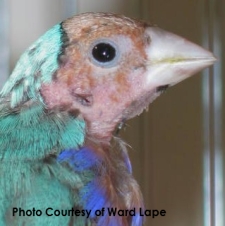 Often you will find that parent birds feeding chicks will lose the facial feathers around their beaks, from feeding large clutches of chicks or many clutches right in a row. Or you may see hens with missing head feathers on the crown of their heads caused by an over aggressive cock during the breeding season. This is not the kind of feather loss that I am referring to here. I am speaking about almost complete and total feather loss on the entire head and neck.
Often you will find that parent birds feeding chicks will lose the facial feathers around their beaks, from feeding large clutches of chicks or many clutches right in a row. Or you may see hens with missing head feathers on the crown of their heads caused by an over aggressive cock during the breeding season. This is not the kind of feather loss that I am referring to here. I am speaking about almost complete and total feather loss on the entire head and neck.
In my experience, I have found that when a quality supplement system is being used and balding occurs in multiple individuals of the same blood line, this can sometimes be attributed to a genetic weakness often related to inbreeding which predisposes the birds in this bloodline to head baldness as a result of a delayed molt. Therefore I would always recommend that you get to the bottom of the problem before allowing any balding birds to breed and produce offspring. Once you have figured out the reason for the baldness these birds could be used to breed from in the future. However, if it is discovered to be a genetic weakness, then this blood line should be stopped and no further breeding done.
If you are properly using a quality supplement system, and you see balding issues with only one individual bird, or multiple birds, but from different bloodlines, you should suspect that there may be a bowel problem in those birds that are bald which is keeping the bird from absorbing the nutrients which are being supplied in the diet. The infective process needs to be determined and a treatment program started to resolve this issue.
It might be an infection
When feathers fall out on the face and head, and the skin takes on a crusty, rough appearance, you should suspect fungal, bacterial or parasitic skin infections. Do not assume that if it is happening in just one bird that it is not an infection because you believe that infections are all contagious. Many infective processes are opportunistic and will only affect birds that have a weak immune system that is incapable of fighting off the infecting organisms.
If this type of balding begins to occur near the end of the molt season, the secondary infections are related to a delayed molt and the lowered immune function of the birds during this time. This type infection would appear in the Northern Hemisphere during May and June and in
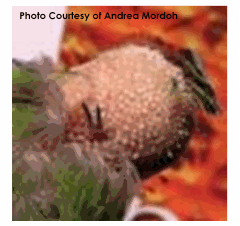 If you have a bald bird with a rough, crusty, scaly appearance to the skin on the head and face, I would suggest that you have a skin scraping done by your local avian vet or submit one to the commercial avian testing lab in the
If you have a bald bird with a rough, crusty, scaly appearance to the skin on the head and face, I would suggest that you have a skin scraping done by your local avian vet or submit one to the commercial avian testing lab in the
Gouldians are unique!
I am sure that every Gouldian owner or admirer will agree that they are one of the most visually unique creatures in the world of birds. But they are also unique in a very special way when it comes to their Molt Cycle. Gouldians have the ability to either speed up (Compressed Molt) or slow down (Delayed Molt) their molt cycle depending upon the availability of food resources and their physiological ability to regrow feathers in any given year.
A Compressed Molt
The Northern Territory of Australia where the Gouldian Finches reside in the wild can be a very harsh place when it comes to food supply. From year to year the seed supply can fluctuate greatly. Gouldians have a preference for Sorghum seed, while other finches that inhabit their same land area will eat a variety of seed types. Following a low volume of wet season rainfall, there may not be adequate Sorghum seed available to facilitate both chick rearing and the subsequent molting cycle for both the adult and juvenile finches produced that year. This fact, coupled with the increase land usage for cattle grazing, in some years the Gouldians will be forced to compress their molting time (speed up the molting cycle) while the seed supply is still plentiful and of good quality to insure that the molt is completed before the end of the dry season and before the wet season begins when torrential rains reduce foraging activity and curtail their ability to fly distances in search of a alternative food supply. The ability of the Gouldians to speed up their molt (a Compressed Molt) appears to be an evolutionary adaptation to the unpredictable climate changes and their preference for a single seed type.
A Delayed Molt
Gouldians will start to molt the first 4 primary flight feathers in late July in
Other conditions that will result in a Delayed Molt are
-
A complete lack of adequate nutrition when the molt should begin
-
The wrong nutrient balance in the diet
-
On-going disease process during the molt (especially air-sac mite infestations, bowel problems, Ornithosis and Polyomavirus, etc.)
-
Climatic changes during the molt cycle (cold spells, fluctuating temperatures and humidity, excessively high humidity or inadequate sunlight, i.e. poor UV spectrum or Vitamin D supplementation)
Molt primes birds for breeding
In my opinion, neither insufficient iodine nor bacterial, fungal or parasitic skin infections are the typical reason why Gouldians go bald. While it is true that head baldness has been seen in other species of finches, with Gouldians it is important to understand that there is a unique relationship between their annual and/or juvenile molt and a successful breeding season to follow this molt. These molts prime the birds into breeding condition. So when sufficient time is not allowed for a complete seasonal molt, the following breeding season is normally not the complete success that you were hoping for and 9 times out of 10 some of your birds will develop balding problems – especially visible on the head. In fact, when you begin to notice head balding beginning during the breeding season, your birds had not even reached the head molt stage during their previous molt period. Always remember, breeding must stop by July 1st in
It is important that Gouldians are in peak condition as they enter their annual and juvenile molting period. For the adult birds, this would require at least a 4 to 6 week resting period between the end of their breeding cycle and the beginning of their molting cycle. Gouldians start to molt the first Primary Flight Feathers in late July in
Segregated Colonies
 The breeding birds need time to regroup their strength from the rigors of breeding. I always separate my birds into single sexed flights at the end of the breeding season to ensure that they are no longer receiving stimulation from their partners to remain in breeding condition, for as long as they remain in breeding condition, they will be unable to devote the proper energies needed to a successful annual molt.
The breeding birds need time to regroup their strength from the rigors of breeding. I always separate my birds into single sexed flights at the end of the breeding season to ensure that they are no longer receiving stimulation from their partners to remain in breeding condition, for as long as they remain in breeding condition, they will be unable to devote the proper energies needed to a successful annual molt.
Balanced diet of upmost importance
During this resting period they need to be supported by a complete and balanced diet. This diet can be provided in many ways and through many methods. But if you are not an experienced bird keeper and/or a nutritional expert, I highly suggest that you do it with one of the many avian supplement systems available on the market today.
Many holistic bird keepers do not believe in what they refer to as “chemical” supplements, and prefer to use a diet containing whole foods. I completely understand their viewpoint, however considering the state of the nutritional content of our foods today, and the fact that Gouldians can be so finicky about eating anything besides seed, it can be hard to provide complete and balanced nutrition with this kind of diet. While it is true that certain plants can be rich in some minerals, the problem is that we have farmed large portions of our farmlands for hundreds of years without replacing the minerals that were removed from the soil with each year’s harvest. It is also true that farmers routinely add Nitrogen, Phosphorous and Potassium to encourage plant growth, but adding these 3 nutrients does not replace all the trace minerals that have been depleted over all these years. So whereas once our soil was mineral rich, unless you are growing your own food using composting methods, or buying organically grown food where composting methods are used to replace the minerals in the soil, you may still have to use supplements in order to provide your birds a complete and balanced diet while feeding them greens, veggies and eggs.
Not a scientific approach…
Even though I have been breeding birds for some 24 years I do not consider myself to be an expert on the nutritional needs of birds. I leave that to the experts out there who have studied and researched it. When I first started out breeding Gouldians, I will admit that I went to the health food store and purchased bottles of vitamins, crushed them with my mortar and pestle and mixed them into the softfoods that I was feeding my birds. Real scientific…huh? I will also admit that I found little success those first few years. I had many losses, balding birds and very few babies.
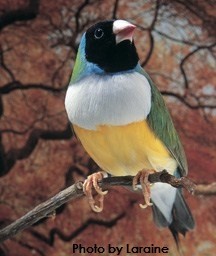 A light bulb came on for me one day at a bird mart in
A light bulb came on for me one day at a bird mart in
Before that day in
You MUST become Mother Nature…
I have been accused over the years of being too controlling with all aspects of my life. And those accusations may be true in some regards, but when it comes to keeping finches, I truly believe that you must take control of their diet and environment, the way Mother Nature would control it in the wild. Otherwise they have no idea what they are supposed to be doing and when they are supposed to be doing it. There are natural triggers that are inbred into them throughout the generations. They know that increasing temperatures and day lengths will trigger the beginning of their annual and juvenile molt. They know that when the rains come (the wet season), that there will soon be a bounty of seeds to raise their babies, so their breeding behavior is initiated. But in captivity, if you feed them the same diet, day after day after day, house them in the same temperatures and lighting conditions throughout the entire year, they have no triggers to tell them what to do and when. In my own aviary, I even go so far as to control the humidity levels so that they have the proper stimulation when required. If I had the capability of changing atmospheric pressure when appropriate…I would do that too, as this is also a stimulus to the behavior of wild birds.
Absolute IMPORTANCE of Molt
All of this is to relate the importance of preparing your birds for their annual and juvenile molt. The molt of a Gouldian in captivity should be uninterrupted by
1. A breeding season extending into what should be their resting cycle, which should always come before the annual molt.
2. Temperature fluctuations once molting has begun.
3. Insufficient or interrupted nutrition during the molting period.
We rarely see a Compressed Molt in our captive Gouldians, but it is possible given the right circumstances. Wild Gouldians have many different natural stimulants provided to them that would tell them that while the seed supply is now good, it could quickly disappear, so they would then speed up their annual or juvenile molt to insure it’s completion within the correct time period. However if any of the things listed above occur during what should be the molting period for your captive Gouldians, you will likely see a Delayed Molting cycle which will then lead to your bald Gouldians, whether a breeding cycle follows or not.
An orderly sequence…
The Primary Flight Feathers of a healthy Gouldian Finch molt one at a time in an orderly sequence. During this period, one, or at most 2 adjacent new flight feathers may be seen growing at any one time. This ensures that the birds will be capable of flight at any time during their molting cycle. The presence of multiple non-adjacent new flight feathers indicates a Compressed Molt. While most of us are not going to catch and inspect our birds to see the progress of the wing molt, doing so will allow you to watch the progress of the molt from a more scientific view point.
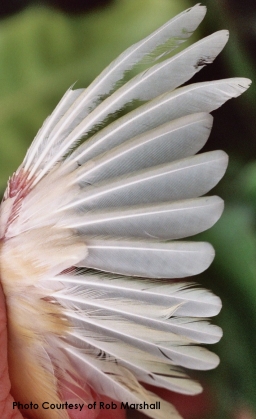 This photo explains the normal molt sequence of the wing prior to the start of the body molt (the early molting cycle). The 4 inner most Primary Flights molt first, before the rest of the Primary Flights, the Secondary Flights and the body molt. However, knowing that the photo was taken well into what should have been the annual molt cycle it tells us that this bird has stalled its molt after the 4 Primary Flights had been replaced because the rest of the Primary and Secondary Flight feathers are much older than one year. The photo shows that the end 6 Primary Flights are very old (more than a year) and fragile and prone to mechanical abrasion and breakage (the 9th and 10th Primary Flights are indeed broken off at this point).
This photo explains the normal molt sequence of the wing prior to the start of the body molt (the early molting cycle). The 4 inner most Primary Flights molt first, before the rest of the Primary Flights, the Secondary Flights and the body molt. However, knowing that the photo was taken well into what should have been the annual molt cycle it tells us that this bird has stalled its molt after the 4 Primary Flights had been replaced because the rest of the Primary and Secondary Flight feathers are much older than one year. The photo shows that the end 6 Primary Flights are very old (more than a year) and fragile and prone to mechanical abrasion and breakage (the 9th and 10th Primary Flights are indeed broken off at this point).
The Secondary Flights are also very old and deteriorated and some of the Coverts are also missing. As long as the problem causing this stalled molt is not corrected, the progress of the molt will not continue. This Delayed Molt could have been stalled by an extended breeding season, temperature fluctuations once the molt had begun or insufficient or interrupted nutrition during the molting cycle.
If the above photo had been taken at the beginning of the molting cycle (July in
You can check the wings of your birds in order to know when you need to stop the breeding cycle and allow them to go thru a complete molt. However waiting until the molt begins to stop the breeding cycle could result in abandoned babies and adult birds that have not had enough time to recoup their strength before the annual molt begins.
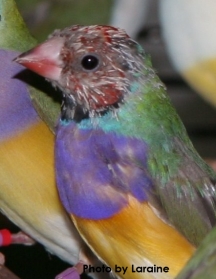 During a Compressed Molt, besides the appearance of multiple non-adjacent new flight feathers, there will be a sudden burst of head pin feathers as the Gouldian’s metabolism causes a spurt in new feather growth. Just like the body and wing feathers are shed and replaced in an orderly fashion, the head feathers should be replaced gradually throughout the 2nd half of the molt. You can see in this photo of a
During a Compressed Molt, besides the appearance of multiple non-adjacent new flight feathers, there will be a sudden burst of head pin feathers as the Gouldian’s metabolism causes a spurt in new feather growth. Just like the body and wing feathers are shed and replaced in an orderly fashion, the head feathers should be replaced gradually throughout the 2nd half of the molt. You can see in this photo of a
 When you see a sudden explosion of head pin feathers, this is a sign that your birds are going thru a Compressed Molt. If the head pin feathers persist like this, the Compressed Molt has been stalled by a Delayed Molt, which will likely result in baldness as breeding season approaches. If you know that you are using a good quality supplement system, this would be an excellent indication that individual birds need further scrutiny as to their bowel health and their inability to absorb that nutrition.
When you see a sudden explosion of head pin feathers, this is a sign that your birds are going thru a Compressed Molt. If the head pin feathers persist like this, the Compressed Molt has been stalled by a Delayed Molt, which will likely result in baldness as breeding season approaches. If you know that you are using a good quality supplement system, this would be an excellent indication that individual birds need further scrutiny as to their bowel health and their inability to absorb that nutrition.
Air-sac Mite Problems during the Molt
Studies done on Sparrows indicate that there will be a decrease in the immune function of birds during their molting cycle. So you should not be surprised to see this same response in your captive Gouldians during their molting cycle. It is believed that a Gouldian with a strong immune function can keep the population of air-sac mites in its respiratory tract in check outside of the molting season. This is how the wild Gouldians have survived thru the years while being infested with air-sac mites. The birds have evolved an elaborate series of preventative and controlling measures using its immune system to keep the air-sac mite from overpowering its respiratory system.
When temperatures and humidity fluctuate during the molt, an inadequate diet is fed, or a bowel problem disrupts the absorption of nutrients from a good diet, thus creating a Delayed Molt, the immune function of our captive birds can be severely impacted. With the added stress of molting on our captive birds, a decreased immune function will permit the air-sac mites within their respiratory tract to begin to multiply and further stress the birds. That is why it is critical that you begin treatments for air-sac mites before the Primary Flight feathers begin to be replaced and continue the treatments every 3 weeks until one month after the conclusion of the annual and juvenile molt.
When the population of air-sac mites becomes large in any bird’s respiratory tract, you won’t even be able to successfully treat them to get rid of the adult population of mites. The simple act of treating to kill air-sac mites can suffocate the bird when the population of dead mites blocks its airway. So you want to keep up the treatments regularly so that the population of mites never gets that large.
For more details on the air-sac mite problem in molting Gouldians, see Dr. Rob Marshall’s article. Relationship of the Moult to Airsac Mite (Sternostoma tracheolum) Infection in the Gouldian finch (Erythura gouldiae)
In Conclusion…
If you have been the disappointed owner of a Gouldian Vulture, and would like to own a Gouldian Beauty, before you reach for “the easy fix” and grab a bottle of Liquid Iodine please, please do a thorough assessment of what you are feeding your birds and how their diet could be improved. Consider whether or not you are taking control of their environment and diet and how this could be improved. There really is an “easy fix” to the problem; it is just a matter of knowing the right one to use!
If you are still unsure, please contact me Laraine@ladygouldian.com and I will be happy to help you find the best approach for you and your flock.
A Success Story…
I had a client contact me in April 2009, about his bald blue-back Gouldian hen. He related that she was slightly bald when he purchased her 4 months earlier, but was told by the seller that she had recently had a clutch of babies and this was normal. She had just hatched another clutch of chicks but they all died by 3 days of age. It was at this point that he contacted me.
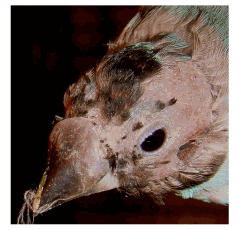 I explained to him about separating her from her mate and allowing her to rest prior to her annual molt. I instructed him about what to feed her and the supplements that she would need during the upcoming molt. The photo at right shows you what her head looked like when I was first contacted. Her ear holes are fully exposed, and she has just a few feathers remaining on top of her head. The skin is smooth and normal in color, so I was sure that she was not suffering from a skin infection.
I explained to him about separating her from her mate and allowing her to rest prior to her annual molt. I instructed him about what to feed her and the supplements that she would need during the upcoming molt. The photo at right shows you what her head looked like when I was first contacted. Her ear holes are fully exposed, and she has just a few feathers remaining on top of her head. The skin is smooth and normal in color, so I was sure that she was not suffering from a skin infection.
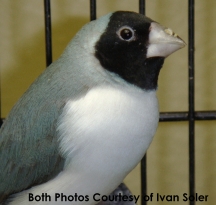 The above photo was taken in April 2009. And this is our young lady today...July 2009 - 3 months after she began her annual molt. Her head feathers have been completely replaced in plenty of time for her to have a normal breeding season this fall. Her beak is still clear and light in color with no hint yet that she is ready to come into breeding condition. I always like showing success stories and what is possible with proper nutrition.
The above photo was taken in April 2009. And this is our young lady today...July 2009 - 3 months after she began her annual molt. Her head feathers have been completely replaced in plenty of time for her to have a normal breeding season this fall. Her beak is still clear and light in color with no hint yet that she is ready to come into breeding condition. I always like showing success stories and what is possible with proper nutrition.




